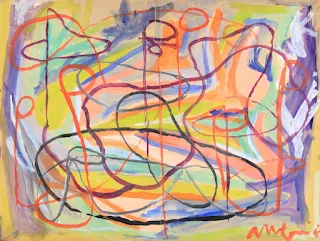Mino Guerrini: A Multifaceted Talent in Italian Cinema and Visual Arts
In the world of Italian art and film, few figures have traversed as many creative landscapes as Mino Guerrini. Known primarily for his contributions to cinema as a director and screenwriter, Guerrini’s artistic talents span a much broader spectrum, including painting and scenography. This blog post aims to celebrate Guerrini’s lesser-known yet profoundly impactful work in the visual arts, providing a glimpse into the versatility of his artistic endeavors.
Early Beginnings
Born in Rome in 1927, Mino Guerrini's artistic journey began at a young age. His father, Oscar Guerrini, a well-known painter, undoubtedly influenced Mino's early exposure to the arts. This nurturing environment laid the foundation for Guerrini’s lifelong relationship with artistic expression.
The Painter
As a painter, Guerrini was deeply influenced by the post-war Italian context, Forma 1 Group, a period marked by a quest for new forms of expression and the breaking of traditional aesthetics. His paintings, characterized by vibrant colors and expressive forms, delve into the abstract while retaining a touch of the figurative—echoes of landscapes and emotions that appear to emerge and recede from the canvas.
His works are emotional landscapes, where the viewer is invited to interpret the flurry of brushstrokes and the interplay of light and shadow. Each piece serves as a testament to Guerrini’s ability to capture and convey complex emotional states, a skill that would later permeate his cinematic works.
Cinematic Influence
In the realm of cinema, Guerrini is perhaps best remembered for his involvement in the giallo film genre, a series of Italian psychological thriller-horror films. His directorial efforts, such as "The Third Eye" (1966) and "Your Sweet Body to Kill" (1967), showcase his knack for creating atmospheric tension and dramatic depth. However, what is particularly noteworthy is how his visual arts background influenced his approach to film direction. Guerrini’s eye for composition and his understanding of color dynamics enriched his cinematic narratives, imbuing them with a distinct visual style that set his films apart from contemporaries.
The Scenographer
Guerrini’s talents also extended to scenography, where he designed sets for both films and theatrical productions. His designs were marked by an imaginative use of space and materials, often creating environments that were both evocative and surreal. This ability to transform spaces into immersive experiences was yet another facet of his artistic genius.
Legacy and Influence
Though Mino Guerrini passed away in 1990, his work continues to inspire new generations of artists and filmmakers. In both his visual and cinematic art, Guerrini left behind a legacy of innovation and creativity. His interdisciplinary approach—melding elements of painting, film, and scenography—highlights the interconnectedness of the arts and how skills in one area can profoundly enhance work in another.
Conclusion
Mino Guerrini’s career is a reminder of the boundless potential of artistic endeavor. By crossing traditional boundaries and constantly seeking new means of expression, Guerrini not only carved a unique niche for himself but also contributed richly to the broader tapestry of Italian art and cinema. As we revisit his works, whether on canvas or screen, we are reminded of the power of art to challenge, transform, and transcend.

